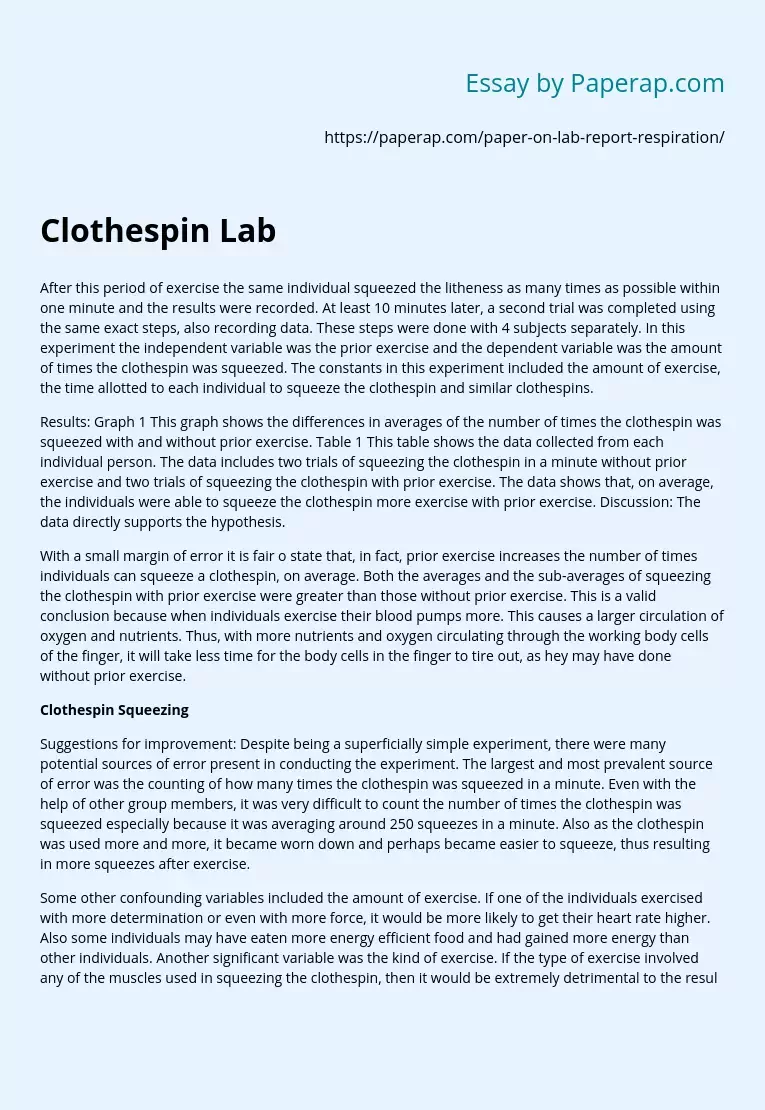Litheness Squeezing Challenge Results
After this period of exercise the same individual squeezed the litheness as many times as possible within one minute and the results were recorded. At least 10 minutes later, a second trial was completed using the same exact steps, also recording data. These steps were done with 4 subjects separately. In this experiment the independent variable was the prior exercise and the dependent variable was the amount of times the clothespin was squeezed. The constants in this experiment included the amount of exercise, the time allotted to each individual to squeeze the clothespin and similar clothespins.
Results: Graph 1 This graph shows the differences in averages of the number of times the clothespin was squeezed with and without prior exercise.
Table 1 This table shows the data collected from each individual person. The data includes two trials of squeezing the clothespin in a minute without prior exercise and two trials of squeezing the clothespin with prior exercise.
The data shows that, on average, the individuals were able to squeeze the clothespin more exercise with prior exercise. Discussion: The data directly supports the hypothesis.
With a small margin of error it is fair o state that, in fact, prior exercise increases the number of times individuals can squeeze a clothespin, on average. Both the averages and the sub-averages of squeezing the clothespin with prior exercise were greater than those without prior exercise. This is a valid conclusion because when individuals exercise their blood pumps more. This causes a larger circulation of oxygen and nutrients. Thus, with more nutrients and oxygen circulating through the working body cells of the finger, it will take less time for the body cells in the finger to tire out, as hey may have done without prior exercise.
Clothespin Squeezing
Suggestions for improvement: Despite being a superficially simple experiment, there were many potential sources of error present in conducting the experiment. The largest and most prevalent source of error was the counting of how many times the clothespin was squeezed in a minute. Even with the help of other group members, it was very difficult to count the number of times the clothespin was squeezed especially because it was averaging around 250 squeezes in a minute. Also as the clothespin was used more and more, it became worn down and perhaps became easier to squeeze, thus resulting in more squeezes after exercise.
Some other confounding variables included the amount of exercise. If one of the individuals exercised with more determination or even with more force, it would be more likely to get their heart rate higher. Also some individuals may have eaten more energy efficient food and had gained more energy than other individuals. Another significant variable was the kind of exercise. If the type of exercise involved any of the muscles used in squeezing the clothespin, then it would be extremely detrimental to the results of the experiment.
The goal of the exercise is not to tire out the muscles but rather to get the heart rate up. In a controlled laboratory there are several ways to prevent these errors and confounding variables. In order to count the clothespin squeezes accurately, one may attach a high tech counting device. This would greatly improve results. Also if there were a controlled exercise that involved none of the muscles used in the experiment it would eliminate several errors and confounding variables. Also to decrease error verbal, increasing sample size would have a substantial effect.
Suggestions for further research: During this experiment several questions were left unanswered and provided suggestions for further research. One of these questions was if increased squeezing of the clothespin was correlated with an increase in heart rate in general. To test this one would have to test different ways of getting someone’s heart rate up such as exercise, scaring, and making them nervous, then make sure that the heart rates are the same, and finally test if the increased heart rate verbal allows that individual to squeeze the clothespin more, or if it is just after exercise.
Another question that was left unanswered was whether a repetition of squeezing the clothespin over a series of months causes the individual to squeeze the clothespin more. To test this one would have to have a large amount of people squeeze clothespins for an allotted time every day for a month, or so. Then the tester would collect all the data and see whether there was an increase in the number of times the individuals were able to squeeze the clothespin within the allotted time.
Litheness Squeezing Challenge Results. (2019, Dec 05). Retrieved from https://paperap.com/paper-on-lab-report-respiration/

